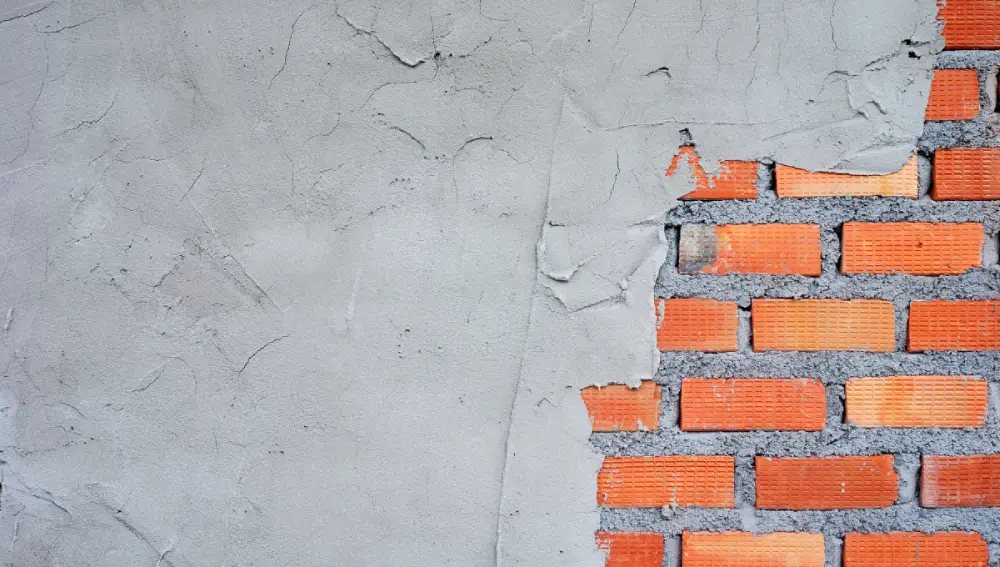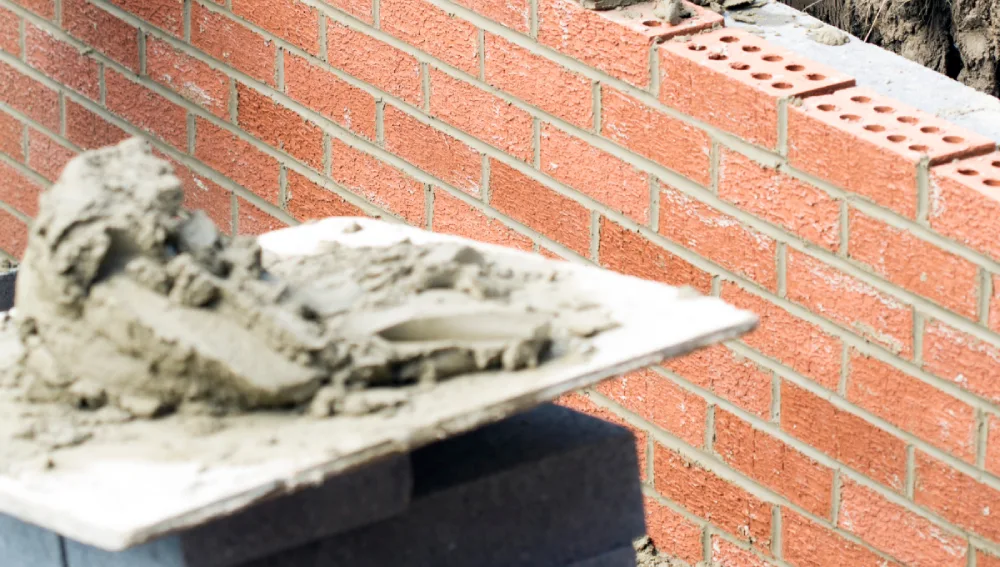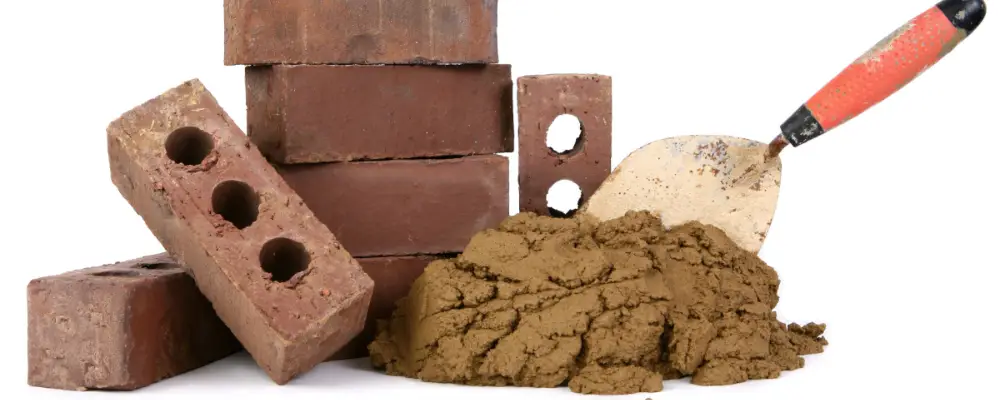If you are constructing a building, either for personal or business use, you may have questions about the correct ratio for brick-and-mortar. Mortar is basically a mixture of cement, sand, lime, and water that, when combined in appropriate ratios, acquires the desired strength, durability, and workability needed for various applications.
In this blog, you will find the ideal ratio, formula, ingredients used, how to mix the brick-mortar, things to be considered, and their importance.
What is the Ratio of Mortar Mix to Brick?

The common ratio for an average brick-mortar mix is 1:3 (1 part cement and 3 parts sand) or 1:4 (1 part cement and 4 parts sand). Here is a general mortar mix ratio for different types of brick walls:
- Normal bricks: 1:4 ratio (1 part cement and 4 parts sand)
- Soft bricks: 1:5 ratio (1 part cement and 5 parts sand)
- Very soft bricks: 1:6 ratio (1 part cement, 6 parts sand, and optionally, 1 part lime). This mixture increases the mortar’s ability to withstand moisture and temperature fluctuations, ensuring a longer-lasting bond.
Water is added to the dry mixture according to the mortar mix used for the bricks.
Formula for Brick-Mortar Ratio
There is no direct formula for calculating the brick-mortar ratio. However, the common specifications of the mortar includes 1:3 and 1:2:9. Either the first or the first two digits refer to a binder, which is cement and lime. The last digit refers to the filler, which denotes sand. It is used in the correct proposition to make a perfect mortar mix for bricks.
For example, in a 1:3 mortar mix, the ratio signifies 1 part binder (cement) and 3 parts filler (sand). Similarly, in a 1:2:9 mix, 1 part cement, 2 parts lime, and 9 parts sand are used.
The choice of ratio depends on the specific requirements of the construction project, including the type of bricks being used, the load the wall needs to bear, and the environmental conditions.
Factors Influencing Mortar Ratios
Various factors influence the mortar ratio for bricks. This includes:
- Type of bricks
- Brick size and
- Thickness of bricks
Type of Bricks
1) Clay Bricks: Traditional clay bricks are known for their porous nature and require a specific type of mortar mix that allows for good adhesion while accommodating slight expansion and contraction. A common mortar ratio for clay bricks is 1:4 (cement to sand) to ensure a strong bond.
2) Concrete Bricks: Concrete bricks are generally denser and less porous than clay bricks. This means they often require a stronger mortar mix, such as 1:3, to ensure proper bonding, especially in load-bearing structures.
3) Fly Ash Bricks: Fly ash bricks, which are lighter and more uniform in shape, might use a slightly different mortar ratio, such as 1:5, to achieve the desired bond strength while accommodating their unique characteristics.
Brick Size
1) Standard Size Bricks: For standard-sized bricks (typically 190mm x 90mm x 90mm), a mortar ratio of 1:4 is commonly used.
2) Larger Bricks: These types of bricks are preferred for industrial or commercial construction, which might require a different mortar mix ratio, like 1:3, to handle the increased surface area and weight, ensuring the bricks are securely bonded.
3) Smaller Bricks: This type of brick often requires a different mix, with a ratio of 1:5, which can be used for lighter loads where flexibility is more important than strength in this case.
Brick Thickness
1) Single Brick Thickness Walls: In walls where the bricks are laid in a single thickness, typically 4.5 inches, the mortar ratio might be lighter, such as 1:5, since the wall is not designed to carry heavy loads.
2) Double Brick Thickness Walls: In double brick thickness walls, such as 9-inch load-bearing walls, the mortar ratio generally needs to be stronger, such as 1:3 or 1:4, to ensure the wall can handle the additional load and pressure.
3) Thicker Walls: For thicker walls or multi-brick walls, particularly in high-rise or industrial buildings, the mortar needs to be even stronger.
In such cases, ratios like 1:3 or even 1:2:9 (cement, lime, sand) might be used to provide extra strength and durability.
Ingredients used for brick-mortar

The ingredients in brick mortar can be categorized into:
- Binder content – The elements such as cement and lime are used for brick mortar, which is used to bind the bricks.
- Filler content – Sand is the primary element used for brick-and-mortar, provides durability and improves strength.
Water is the main component used to mix and activate the chemicals present in brick mortar.
Importance of Water-Cement Ratios
In general, Water-Cement ratio is important in both design and performance of concrete and mortar as it affects strength and durability. It is expressed in W/C ratio where W represents weight of water and C represents weight of cement in a concrete mix.
Lower water-cement ratio generally results in higher strength concrete. This is because less water means fewer pores in the hardened concrete, which improves its overall strength.
Ratios as low as 0.40 are often used for high-strength concrete applications.
On the other hand, a higher water-cement ratio increases the amount of water in the mix, leading to more pores in the hardened concrete. This reduces the strength of the concrete, and more susceptible to cracking under load.
How to Mix Brick-Mortar
Here are the steps that are included for mixing brick mortar.
The steps are:
- Use a clean, dry bucket to measure the elements that are required for the mortar mix.
- Understand the requirements and measure them in an appropriate ratio.
- Use plastic tubs or a mixing board to mix the mortar. Before mixing them, pre-wet the container or the surface so the ingredients do not get stuck to it.
- Add the required ingredients, such as cement, sand, and water (lime, if needed). It differs according to the need for the buildings.
The exact proportions of these ingredients depend on the specific requirements of the building project.
For example, a standard mortar mix for most residential construction might be in the ratio of 1:4 (cement to sand), while heavier structures may require a stronger mix like 1:3.
Lime is often added in a ratio of 1:2:9 (cement, lime, sand) for projects which adapts for restoration work.
- Add water gradually as per the need for the mixture. Fold the mortar up and down when the mixture is prepared in your hands.
- Stop mixing the mortar once it reaches the right consistency and becomes wet enough; then, it is ready to be applied between bricks.
What is the good mortar ratio?
| Types of Brick Wall | Ratio of Mortar Mix |
| Load bearing walls | 1:3 to 1:4 |
| Non-Load bearing walls | 1:4 to 1:6 |
| Exterior walls | 1:3 to 1:4 ( by adding lime ) |
| Interior walls | 1:4 to 1:6 |
Things to consider before mortar mix
The three important things to consider before mixing the mortar are
- Temperature – If you are planning to apply mortar for bricks then you must note the weather conditions. It should not be 5 degrees or less than 5 degrees. This is because the mixer will freeze, and it becomes weak.
- Mixing technique – The mortar can be mixed either by hand or cement mixture. You can plan according to the requirements of your buildings.
- Have a trial – Before applying the mixture to the bricks try once if the ratio of the mortar is good enough to apply. If there is any correction sort it out and find the best mortar mix to apply.
Why it is Important?
The correct mortar ratio is important because
- Protects the wall from damage and prevents cracks on the wall.
- Maintains the proper structure for the buildings and ensuresthe perfect shape for the corners.
- If there is a perfect ratio, then the appearance and thickness of the wall looks good.
- It gives the proper consistency to apply between the bricks.
- If any of the ratios becomes high or low, then it damages the total buildings.
Conclusion
Measuring and mixing the required elements in the correct ratio gives the perfect output. Following these measurements improves the durability, provides the perfect finish, prevents damage to the wall, and makes the building more elegant.
FAQs
The answer is that 120 kg of cement is used for 1000 standard-sized bricks. However, it varies according to the surroundings of your wall and the thickness used to join between the walls.
Masonry cement is the most common cement used in mortar as it is more consistent. In the old technique, portland cement was used for brick mortar.

